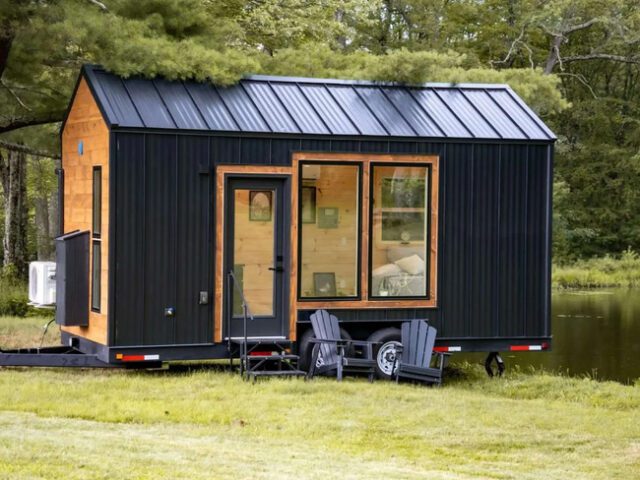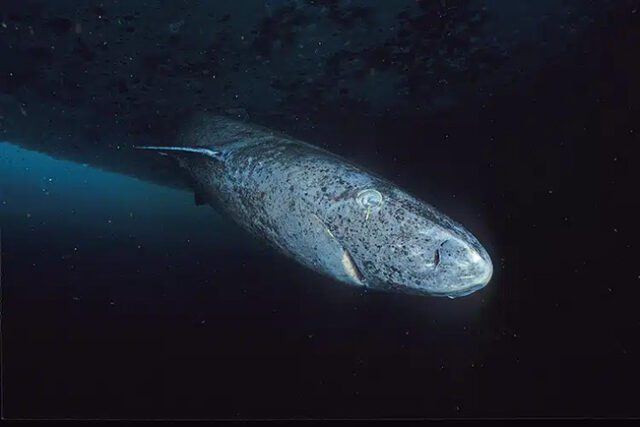
The Kemi tiny home, designed by Dragon Tiny Homes, is a compact yet stylish dwelling inspired by Scandinavian design, offering a serene and minimalist living experience. Priced at $50,000, this 20-foot-long home is built on a double-axle trailer, making it an ideal option for those seeking a versatile vacation home or guesthouse. The exterior features sleek black standing seam metal siding with wooden accents, adding a modern touch that complements the subtle Continue reading “The Kemi Tiny Home Is a Scandinavian-Influenced Dwelling with a $50K Price Tag” »

The Greenland shark (Somniosus microcephalus) has captured scientists’ fascination due to its extraordinary longevity, with some individuals living for up to 500 years. As the longest-living vertebrate known to science, these sharks offer a unique window into understanding the biological mechanisms that control aging. Their ability to thrive in the harsh, frigid waters of the Arctic, coupled with their slow metabolism, may hold the key to their extended lifespans. Researchers have discovered that the metabolism of these sharks remains stable, without the typical age-related decline seen in humans, suggesting that the Greenland shark may possess mechanisms that prevent the usual markers of aging. By studying these sharks, scientists hope to unlock new insights into how we might extend the human lifespan or improve the quality of life as we age.

In addition to their remarkable lifespans, Greenland sharks exhibit other fascinating biological traits that make them a subject of intense study. Their slow growth rate and late sexual maturity, with reproduction only beginning around the age of 150, are likely adaptations to the challenging environment of the deep Arctic waters. These sharks have low natural mortality rates, and their life strategy seems to be centered on slow, steady growth and energy conservation, which may contribute to their longevity. Biologist Ewan Camplisson suggests that understanding the resilience of Greenland sharks to age-related diseases, such as cardiac issues, could provide valuable insights into improving human health. By uncovering the secrets of the Greenland shark’s long life, scientists hope to find ways to combat the aging process and enhance the quality of life for humans, especially as we face the challenges of an aging population.

In a quiet corner of London’s Islington district, a dead-end road has become an unexpected tourist attraction thanks to the artistry and devotion of Tim Bushe, an architect who has turned hedge trimming into a heartfelt tribute to his late wife, Philippa. Over the years, Bushe has meticulously sculpted the hedges along his street into an open-air gallery of green sculptures, each creation serving as a living memory of their life together. His work began with a simple Continue reading “Hobbyist Hedge Trimmer Transforms His Street into Green Sculpture Gallery in Memory of Beloved Wife” »

Ella Baudinet’s monumental oil paintings are a captivating fusion of classical realism, surreal abstraction, and modern sensibilities. Her work draws viewers into a dreamlike realm where human figures seem to materialize from smoky swirls of color, blending the precision of photorealism with the imaginative fluidity of abstraction. Influenced by the grandeur of Baroque art, Baudinet’s figures exude a timeless quality, yet they are enveloped in a mysterious atmosphere that feels distinctly contemporary. Her unique style reflects a deep commitment to following her instincts, leading her to evolve from a young photorealistic artist into a painter whose canvases resonate with emotional depth and a powerful visual narrative.

Baudinet’s artistic journey is characterized by a deliberate choice to embrace beauty in a time when much of contemporary art leans towards discomfort and exclusion. Her move to London has further fueled her growth, allowing her to refine her vision and produce work that is not only technically impressive but also spiritually uplifting. By rejecting the modern trend of dismissing beauty as superficial or outdated, Baudinet aims to inspire viewers to connect with their inner selves and find meaning in her art. Her paintings are a testament to the enduring power of beauty, crafted with a mastery that seeks to engage the soul rather than merely the intellect. In doing so, Baudinet challenges the contemporary art world’s norms, advocating for a return to celebrating art that resonates with both the heart and the mind.








Stargazers, get ready for a celestial treat! In just a few days, the night sky will be graced by a rare supermoon blue moon, an extraordinary event that combines two captivating lunar phenomena. This August’s full moon, the brightest and largest of 2024, will also be blue, making it a doubly special occasion. A supermoon occurs when the Moon is at its closest approach to Earth, appearing about 14% larger and 30% brighter than usual. Although light pollution can dim its brilliance, the sight is still awe-inspiring, with the moon seeming unusually big and bright against the night sky.

Adding to the spectacle is that this supermoon is also a blue moon, a term that might sound like the Moon will turn blue but refers to the rare occurrence of a third full moon in a season with four full moons. The upcoming August full moon, also known as the Sturgeon Moon, will peak at 2:26 p.m. ET on August 19, 2024. Although it will be at its zenith during the daytime in the U.S., the Moon will still appear full and radiant for several days, from Sunday morning to early Wednesday morning. If you miss this event, don’t worry—there are three more supermoons scheduled for this year, giving you plenty of chances to witness this stunning natural display.



Wildlife photographer Joe Moreno recently embarked on an extraordinary journey to Lake Clark National Park in Alaska, where he captured the intimate and majestic lives of the Alaska Peninsula brown bears, often known as “peninsular grizzlies.” These bears, among the largest of their kind, roam the lush forests and pristine rivers Continue reading “Wildlife Photographer Captures Intimate Photos of Alaska’s Grizzly Bears” »

On July 22, a sudden wildfire erupted in Jasper National Park, rapidly engulfing the Canadian forest and forcing an urgent evacuation of hikers and campers. Among those facing the risky situation was 18-year-old Colleen Knull, a volunteer firefighter working a summer job as part of the kitchen staff at a local lodge. As smoke billowed from the mountainside, Knull quickly sprang into action, alerting the lodge guests and searching for other campers. Displaying remarkable leadership and courage, she gathered 16 people and guided them through a challenging four-hour trek in the dark, navigating treacherous terrain and dense smoke to bring everyone to safety.

Rebecca Tocher, one of the evacuees, praised Knull for her extraordinary leadership during the harrowing escape. Despite the intense smoke and falling ash, Knull remained calm and used her familiarity with the trail to navigate the group to safety. Relying on her tracking skills and prior knowledge of the area, including counting cut logs and following horse tracks, Knull expertly led the group through the dangerous conditions. Eventually, they reached a pickup truck, where Knull managed to fit all 16 people and drive them to safety, avoiding serious injuries. Her actions not only highlight her bravery and resourcefulness but also underscore her deep compassion for others, a trait that will undoubtedly serve her well as she pursues a career as a full-time firefighter.

Nearly 20 years ago, Canadian blogger Kyle MacDonald captured the imagination of the internet by trading his way from a red paperclip to a two-story home. Inspired by the childhood game “Bigger, Better,” where the objective is to trade an item for something more valuable, MacDonald embarked on this unique journey in July 2005. Tired of paying rent in Montreal and seeking a home of his own, the 26-year-old set up a website to document his quest. With a red paperclip as his starting point, he promised to visit anyone willing to trade with him. This ambitious venture set off a remarkable chain of 14 trades, culminating in the acquisition of a $50,000 home in Kipling, Saskatchewan. MacDonald’s success story became a symbol of creativity, determination, and the power of community, as he demonstrated that with the right mindset, anything is possible.

The journey from a simple office supply to a home was far from straightforward. MacDonald’s first trade involved swapping the red paperclip for a fish-shaped pen, which he then exchanged for a hand-sculpted doorknob. Each subsequent trade took him across North America, from a camping stove to a generator, and even a snowmobile, showcasing his ingenuity and persistence. His adventure reached its peak when he traded a motorized KISS snow globe, a seemingly trivial item, for a speaking role in a film, thanks to actor Corbin Bernsen’s passion for snow globes. This pivotal trade led the town of Kipling to offer him a farmhouse, marking the end of his year-long quest. MacDonald’s journey not only secured him a home but also inspired countless others, leaving a lasting legacy in Kipling, where the Paperclip Cottage Cafe now stands as a testament to this incredible story.

The concept of “sponge cities” in China, pioneered by landscape architect Yu Kongjian, represents a transformative approach to urban flooding by harnessing the natural environment. Yu’s firm, Turenscape, has spearheaded numerous projects across China that employ native plants, soil, and strategic design to absorb and channel rainwater away from urban areas. Unlike traditional flood control methods, such as concrete barriers and drainage systems, Yu’s nature-based solutions are flexible, cost-effective, and require minimal maintenance. In a country where 641 out of 654 large cities face regular flooding, this innovative approach is crucial. Yu argues that relying solely on artificial structures to control water is a flawed strategy, as they can be inflexible and expensive, often requiring constant upkeep. Instead, by reimagining urban landscapes as “sponges” that work with nature rather than against it, Yu’s projects mitigate flooding while simultaneously restoring polluted or abandoned lands.

Turenscape’s sponge city projects have become a model of sustainable urban design, blending ecological restoration with urban resilience. Examples like Nanchang Fish Tail Park and Sanya Mangrove Park showcase how Yu’s vision not only addresses flooding but also revitalizes environments, turning degraded sites into vibrant, functional landscapes. These parks, built on formerly polluted or barren land, now serve as thriving ecosystems that also provide recreational spaces for millions of people. The adaptability of sponge cities allows for targeted, efficient interventions that create interconnected webs of green spaces capable of managing rainwater. In cities like Wuhan, where over 300 sponge projects have been implemented, the cost of these green infrastructure solutions was significantly lower than traditional concrete-based alternatives. This success has earned Yu international recognition, including the $100,000 Oberlander Prize, highlighting the global relevance of his nature-based solutions for urban challenges.











































